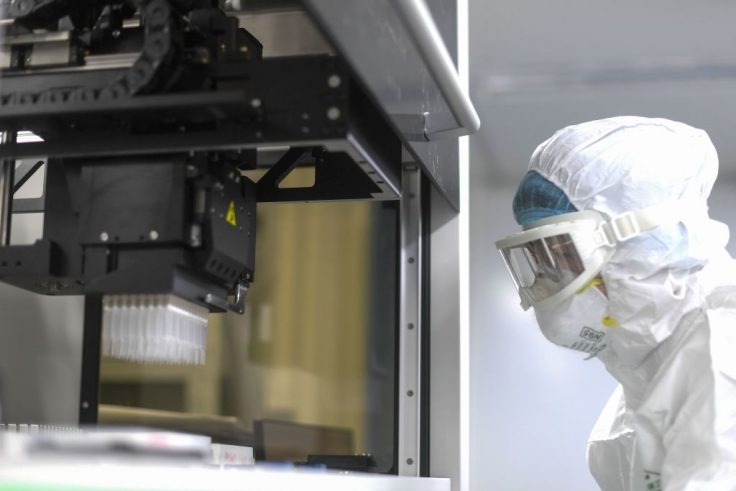Many media outlets have ignored a new report showing American officials warned in 2018 that research at a Wuhan superlab could create a pandemic, even as reporters branded lawmakers conspiracy theorists for suggesting a potential connection between the lab and the coronavirus outbreak.
Sen. Tom Cotton (R., Ark.) was pilloried in the mainstream media for questioning the Chinese regime's claim that the deadly virus was passed to humans in a Wuhan seafood market. In a Feb. 16 interview with Fox News, Cotton floated the possibility that the outbreak may have originated at the Wuhan Institute of Virology, China's only top-level biosafety lab that researches human infectious diseases. Publications from the New York Times to the Washington Post and CNN wagged the finger at those who suggested a potential connection.
Cotton's claim may not be as "evidence-free" as his critics suggested. On Tuesday, the Washington Post's Josh Rogin uncovered a series of 2018 State Department cables that warned of poor safety measures at the institute, which was conducting work on bat coronaviruses and possible human transmission. U.S. embassy officials were so troubled by their observations that they informed Washington of the risks, encouraging greater American assistance to the lab for its important but dangerous research.
The revelations have not caused the media to reevaluate their treatment of Cotton and others who warned about the lab. Reporters at the New York Times, Washington Post, and CNN did not respond to requests for comment about whether they plan to update past pieces that characterized scrutiny of the lab as a "fringe theory."
In a Feb. 17 piece headlined, "U.S. Senator Repeats Fringe Theory Casting Virus as Communist Party Weapon," the New York Times's Alexandra Stevenson reported that Cotton had spread a "tale" that resonated with fellow China hawks on the right. Cotton was also tagged in an April 8 piece from Times blogger Max Fisher, headlined, "Why Coronavirus Conspiracy Theories Flourish. And Why It Matters." Fisher focused on Cotton's suggestion that the virus could be a Chinese weapon, later amending the article to note Cotton said that was one of several possible explanations.
The Washington Post published several pieces critical of Cotton's comments before publishing Rogin's report. A Feb. 17 piece by Paulina Firozi said Cotton repeated a conspiracy theory "that has repeatedly been debunked by experts." The article quoted Rutgers professor Richard Ebright, who cast aside the notion that the virus was manufactured by humans. The same professor later told the Post's David Ignatius, however, that the possibility it emanated from a lab accident could not be discounted.
The Post also negatively cited Cotton in a March 5 story, comparing his remarks to Chinese conspiracy theories blaming the United States for the coronavirus.
"Fringe theories, to be sure, have been widely floated on both sides of the Pacific," reporter Gerry Shih wrote. "Sen. Tom Cotton (R., Ark.) speculated last month on Fox News that the virus may have escaped from a Wuhan lab that researched dangerous pathogens, repeating a popular theory that had been debunked by scientists."
On Wednesday, the day after Rogin published his report on the State Department cables, the Post's PowerPost newsletter by Jacqueline Alemany called Cotton's comments in February an amplification of a "conspiracy theory." The Republican also took heat from the Washington Post editorial board, which compared him on March 29 to the spokesman for China's foreign ministry, Zhao Lijian, who had accused the U.S. Army of introducing the virus to China.
CNN's Chris Cillizza wrote Feb. 18 that it was the "height of irresponsibility" for Cotton to float an "evidence-free conspiracy theory."
Similar articles criticizing Cotton appeared in MSNBC, the Daily Beast, the Atlantic, Business Insider, and USA Today.
When he spoke with Fox News on Feb. 16, Cotton acknowledged that he did not have proof of the virus's origins but still felt an investigation was needed due to China's secrecy. It has since been established that China initially covered up the virus's outbreak and could have dramatically reduced its global spread with more aggressive action.
Cotton told the Washington Free Beacon that while we still do not know the exact origins of the virus, the Chinese Communist Party's story did not add up.
"We do know that a natural animal-to-human transmission or an accidental breach from a lab studying coronavirus—like the one in Wuhan—remain the most likely options," he said. "Unfortunately, several media outlets reported that by merely suggesting the virus could have come from a lab, I was spreading conspiracy theories. Now, many of those same outlets have reversed course, reporting that a lab-release origin shouldn't be discounted. We should continue to follow the scientific evidence where it leads and ultimately hold China accountable for its responsibility in the spread of this deadly disease."
